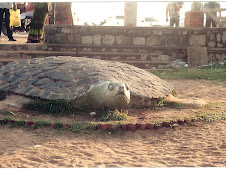Coming in on the Chennai – Jaipur Express, we really hadn’t had much of a chance to take in the change in the vegetation around. Having reached Sawai Madhopur at 3.45 am, we had all been eager to get to the Tiger Safari Resort – anyway, there was little chance to scan the plant life at that hour. But Sivakumar, who had flown in to Jaipur before connecting to Sawai Madhopur had seen the land carpeted with dry trees, with just a few patches of green showing through. Inside the Ranthambore National Park too, there was little green. Branches of the dhok trees mingled with each other, the network of their thin twigs creating an impression of a grey, dusty cloud hanging about 10 feet off the ground. The ground, of course was almost completely barren, with no undergrowth worth its name.
That’s what makes it easier to spot the animals, say the guides, assuring us that we are visiting at the best time for tiger sightings. A couple of weeks later, it will be too hot even for the large animals to venture out and sightings will be down, close to nothing. The hot season will last until July/August, when the monsoons will begin. Within a week of the raindrops hitting the ground, the dhok will be flush with new shoots, plants will spring up from the undergrowth, providing far better cover to animals moving around, making it even more difficult to spot them, even those chitals and sambhar which are now seen at every turn.
Going into Zone 4 in a Gypsy, we didn’t believe sightings could get any more difficult; our criss-crossings didn’t show us even a single hair of a tiger, but we did spend a few minutes taking in an awesome view of the valley, sharing it with a honey buzzard who circled lazily overhead before wheeling away from us. In those few minutes we lost the other Gypsy in Zone 4; they got to see a tiger across a check dam, even though it was nowhere as close as it was the previous day. Not knowing of their sighting, we spent some time trying to find the Brown Fish Owl and ending up with a pair of Painted Spurfowl. Our lunch was rather somber, for a third among us had not seen a tiger on any of the three safaris that we had been on.
Afternoon was into Zone 5, for the second time. We weren’t going to Bakola, however. Rajendar Sharma, our guide, waxed eloquent on how his childhood was spent wandering through the forest, of which he could remember every nook and cranny. Outsiders, he said, are welcome as guests, but too many have strained their welcome by staying on and usurping jobs the locals could otherwise have had for themselves. Despite all the distractions he had in expounding his philosophy, he managed to take us to a check dam with a bit of water in it. On the other side, hiding in a thicket was a young male tiger, watching the three or four vehicles that had gathered by then, rather incuriously. And then, deciding that we’d earned ourselves a better view, he sauntered down to the water, soaked himself in it for a few minutes and ambled back, deeper into the thicket, shutting off our view. We had him in view for about ten minutes and we waited for another ten before giving up and going around to see other parts of the forest, those that we would have no hesitation in certifying as being “100% tiger-free”. Maybe to chastise us for our lack of focus on the tiger – and our lack of faith in its presence throughout the forest – our Gypsy had a puncture on the way back. Here was a justifiable reason to get out of the vehicle and set foot on the forest floor, which all of us did. The chastisement was in full force, for we were stuck at a spot that did not seem to have any sign of life – no animal, no bird, insect nor plant, save for the dormant dhok trees all around. It was a rather mundane outing and had it not been for the bathing tiger, the kids – Kedar, Roshan and Uttara especially – would have probably turned into tigers themselves, growling in their disappointment.
Not Girish, though. He was in the Gypsy that had gone into Zone 2, turning off at the entrance and heading straight to Padam Tal, where they parked for almost two-and-a-half hours. For a large part of that time, they were treated to a wonderful show by a tiger which had been lying up in the tall grass bordering the lake for a while before coming out and gamboling on the shore, allowing Girish some splendid photographs that he is justifiably proud of.
At the end of the second day, everyone had had at least one sighting of the tiger – and so plans were being made for sampling the other attractions. Sivakumar and Kumar had anyway made their foray into Sawai Madhopur town on the first evening itself, using the matki dahi and the ganne-ka-ras available on the streets to wash away the heat of the afternoon. The extremity of the heat can be sensed when you hear that the sun glowed silvery-white, rather than the customary red, as it was setting that evening. The second evening was almost balmy by contrast, though the temperature during the day had touched 46°C. The bird list had grown, and was now in the mid-80s, but still far below the ‘official’ count of 274.
Subscribe to:
Post Comments (Atom)

No comments:
Post a Comment